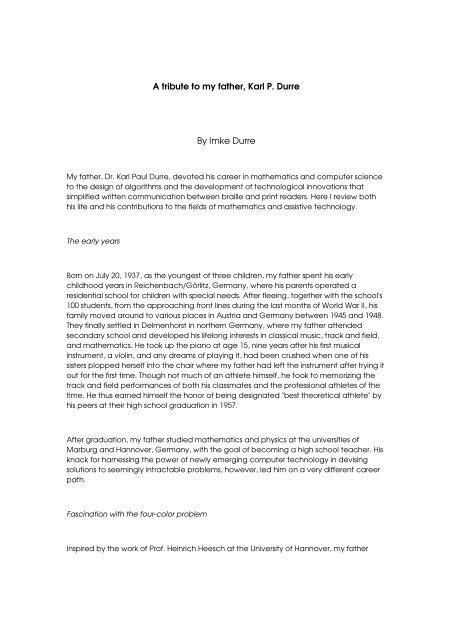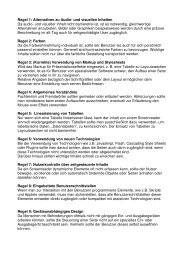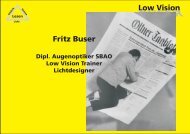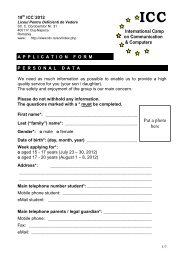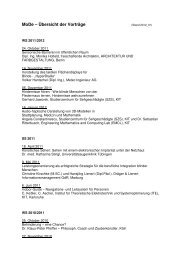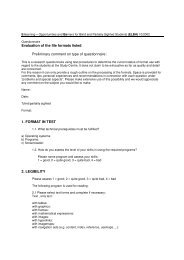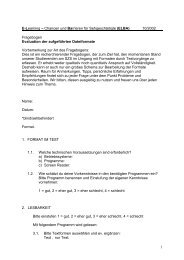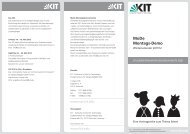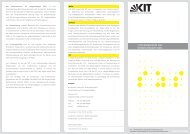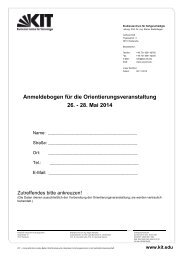A tribute to my father, Karl P. Durre By Imke Durre - SZS
A tribute to my father, Karl P. Durre By Imke Durre - SZS
A tribute to my father, Karl P. Durre By Imke Durre - SZS
Create successful ePaper yourself
Turn your PDF publications into a flip-book with our unique Google optimized e-Paper software.
A <strong>tribute</strong> <strong>to</strong> <strong>my</strong> <strong>father</strong>, <strong>Karl</strong> P. <strong>Durre</strong><br />
<strong>By</strong> <strong>Imke</strong> <strong>Durre</strong><br />
My <strong>father</strong>, Dr. <strong>Karl</strong> Paul <strong>Durre</strong>, devoted his career in mathematics and computer science<br />
<strong>to</strong> the design of algorithms and the development of technological innovations that<br />
simplified written communication between braille and print readers. Here I review both<br />
his life and his contributions <strong>to</strong> the fields of mathematics and assistive technology.<br />
The early years<br />
Born on July 20, 1937, as the youngest of three children, <strong>my</strong> <strong>father</strong> spent his early<br />
childhood years in Reichenbach/Görlitz, Germany, where his parents operated a<br />
residential school for children with special needs. After fleeing, <strong>to</strong>gether with the school's<br />
100 students, from the approaching front lines during the last months of World War II, his<br />
family moved around <strong>to</strong> various places in Austria and Germany between 1945 and 1948.<br />
They finally settled in Delmenhorst in northern Germany, where <strong>my</strong> <strong>father</strong> attended<br />
secondary school and developed his lifelong interests in classical music, track and field,<br />
and mathematics. He <strong>to</strong>ok up the piano at age 15, nine years after his first musical<br />
instrument, a violin, and any dreams of playing it, had been crushed when one of his<br />
sisters plopped herself in<strong>to</strong> the chair where <strong>my</strong> <strong>father</strong> had left the instrument after trying it<br />
out for the first time. Though not much of an athlete himself, he <strong>to</strong>ok <strong>to</strong> memorizing the<br />
track and field performances of both his classmates and the professional athletes of the<br />
time. He thus earned himself the honor of being designated "best theoretical athlete" by<br />
his peers at their high school graduation in 1957.<br />
After graduation, <strong>my</strong> <strong>father</strong> studied mathematics and physics at the universities of<br />
Marburg and Hannover, Germany, with the goal of becoming a high school teacher. His<br />
knack for harnessing the power of newly emerging computer technology in devising<br />
solutions <strong>to</strong> seemingly intractable problems, however, led him on a very different career<br />
path.<br />
Fascination with the four-color problem<br />
Inspired by the work of Prof. Heinrich Heesch at the University of Hannover, <strong>my</strong> <strong>father</strong>
ecame fascinated with "coloring problems," an area of mathematics concerned with<br />
the number of colors required for distinguishing adjoining countries on a map. Under Dr.<br />
Heesch's tutelage, <strong>my</strong> <strong>father</strong> participated in the search for a proof <strong>to</strong> the Four-Color<br />
Theorem. This theorem states that four colors suffice <strong>to</strong> color an arbitrary map where<br />
countries with common borders must be colored differently. Devising innovative<br />
techniques for utilizing the limited amount of computer memory, <strong>my</strong> <strong>father</strong> designed and<br />
implemented an algorithm for performing computations that formed the basis for the<br />
later proof of the theorem. It is this work that was the subject of his doc<strong>to</strong>ral dissertation<br />
and led <strong>to</strong> his earning a Ph.D. in mathematics in 1969 from the University of Hannover,<br />
Germany.<br />
The availability of more advanced computing resources in the United States brought <strong>my</strong><br />
<strong>father</strong> <strong>to</strong> Brookhaven National Labora<strong>to</strong>ry on Long Island in 1968 and 1969. The invitation<br />
<strong>to</strong> Brookhaven was extended by Dr. Yoshio Shimamo<strong>to</strong>, who himself was working on the<br />
four-color problem and saw great potential in the <strong>Durre</strong>-Heesch algorithm. While there,<br />
<strong>my</strong> <strong>father</strong> enjoyed the classical music and opera scenes of New York City and traveled<br />
the country extensively by car. These experiences left him with memories and s<strong>to</strong>ries that<br />
he enjoyed sharing with his family for the rest of his life and in part con<strong>tribute</strong>d <strong>to</strong> his later<br />
permanent move <strong>to</strong> the United States.<br />
After returning <strong>to</strong> Germany from Brookhaven, he continued <strong>to</strong> pursue his interest in<br />
graph-coloring algorithms and their application <strong>to</strong> the compression of sparsely<br />
populated data bases. As a research scientist, he first conducted this work in the<br />
Department of Mathematical Machines and Data Processing at the University of<br />
Erlangen and in 1971 transferred <strong>to</strong> the newly established Department of Computer<br />
Science at the University of <strong>Karl</strong>sruhe. He married in 1971 and had two children with his<br />
wife Ingeborg, <strong>Imke</strong> and Holger.<br />
Pioneering software development<br />
My <strong>father</strong>'s passion for assistive technology was inspired by <strong>my</strong> blindness and <strong>my</strong> parents'<br />
desire <strong>to</strong> provide me access <strong>to</strong> an equal and appropriate education without sending me<br />
<strong>to</strong> a residential school. In Germany during the late 1970s, there was no support system of<br />
vision resource teachers, meaning that children with disabilities had <strong>to</strong> attend a special<br />
school. After locating a school principal who was willing <strong>to</strong> support <strong>my</strong> parents’ attempt<br />
<strong>to</strong> mainstream me in the neighborhood school system, the Department of Education of<br />
our home state eventually granted the school special permission <strong>to</strong> try this educational<br />
experiment, under the premise that <strong>my</strong> parents would provide the support necessary <strong>to</strong><br />
access educational materials for me. It was unders<strong>to</strong>od that they would also take care<br />
of the issue with access <strong>to</strong> <strong>my</strong> written homework and tests for <strong>my</strong> classroom teachers. This<br />
was possible since <strong>my</strong> <strong>father</strong> developed a computer-aided system that would allow for<br />
direct written communication between blind students and their sighted teachers, peers,
and family members.<br />
Having chosen the recently released VersaBraille from Telesensory, Inc., as the<br />
appropriate electronic braille reading and writing device, <strong>my</strong> <strong>father</strong> tried <strong>to</strong> locate<br />
software that would allow this device <strong>to</strong> provide instantaneous braille input and output<br />
when connected <strong>to</strong> a personal computer. Unable <strong>to</strong> find what he was looking for, he<br />
conceived new software and interested one of his students, Thomas Friehoff, in the<br />
implementation of his vision. The result was BrailleButler, a screen reader and braille<br />
display-friendly edi<strong>to</strong>r for the Apple IIe. The first version was completed in September<br />
1983, the night before I entered fifth grade in a regular German secondary school.<br />
Before long, the system was also used by several other blind children whose parents<br />
desired a mainstream education for them. BrailleButler was eventually dis<strong>tribute</strong>d and<br />
further developed by Baum Elektronik which Thomas Friehoff later joined.<br />
Direct written communication through 8-dot computer braille<br />
One particularly useful aspect of the BrailleButler was its reliance on an uncontracted<br />
braille code that made full use of all eight dots available in computer braille characters,<br />
thus allowing for a one-<strong>to</strong>-one correspondence between print and braille characters. At<br />
that time, the number of dots in braille displays was limited <strong>to</strong> 6 dots per cell. To increase<br />
the number of unique dot combinations, <strong>my</strong> <strong>father</strong> conceived a method for simulating<br />
the addition of dot 7 only, dot 8 only, and dots 7 and 8 <strong>to</strong>gether by way of different<br />
speeds of vibration of the 6-dot characters. Six-dot characters <strong>to</strong> which only a dot 7 was<br />
added, e.g., the capital A, vibrated the fastest, characters containing both dots 7 and 8<br />
vibrated the slowest, and characters <strong>to</strong> which only dot 8 was added vibrated at an<br />
intermediate speed. Since the VersaBraille model on the market at the time did not have<br />
this vibrational capability, <strong>my</strong> <strong>father</strong> arranged with Baum, Telesensory's distribu<strong>to</strong>r in<br />
Germany at the time, <strong>to</strong> have a VersaBraille specially adapted for me. Soon, the<br />
expanded functionality became a standard feature for all new VersaBraille units. Around<br />
1990, with the advent of braille displays with 8-dot cells, the true 8-dot characters<br />
replaced the different modes of vibration.<br />
Picture 1: The 8-dot braille cell.<br />
1• •4<br />
2• •5<br />
3• •6<br />
7• •8
Whether dots 7 and 8 were virtual or real, their use made it possible <strong>to</strong> expand the<br />
number of symbols that could be represented with one braille character <strong>to</strong> four times the<br />
number available in the traditional 6-dot system. Thanks <strong>to</strong> this expansion, blind students<br />
now had a sufficient number of symbols <strong>to</strong> write all assignments, including those in math<br />
and foreign languages, on the computer in a form that both they and their sighted<br />
teachers could read. Conversely, any person without knowledge of braille was able <strong>to</strong><br />
make texts accessible <strong>to</strong> the blind student by entering them in<strong>to</strong> a regular word<br />
processor on a conventional QWERTY keyboard. Furthermore, the simultaneous<br />
appearance of text in print on the moni<strong>to</strong>r and in braille on the refreshable braille display<br />
facilitated direct written communication between blind and sighted individuals in school<br />
and in employment settings, thus greatly simplifying the integration of blind individuals<br />
in<strong>to</strong> the regular classroom and working world.<br />
Picture 2: A refreshable braille display with 8-dot braille cells.<br />
In a 1991 conference paper, <strong>my</strong> <strong>father</strong>, in collaboration with Dean Tuttle and <strong>my</strong> mother,<br />
presented an Americanized version of the 8-dot code in which print symbols were<br />
matched with braille dot combinations familiar <strong>to</strong> the American braille reader. The<br />
authors argued that this system represented “a user friendly universal braille code that<br />
permits the combination of literary English texts with foreign language and/or
mathematical texts.” They regarded an 8-dot code as an appropriate answer <strong>to</strong> the<br />
revived search for a universal English braille code, rather than the 6-dot code others<br />
proposed. Their paper is frequently cited in discussions about a universal braille code for<br />
the English language and has been brought <strong>to</strong> the attention of the Braille Authority of<br />
North America (BANA), the official entity regulating the usage of braille in the U.S. and<br />
Canada. However, even though computers are now widely used in all areas of life, a<br />
variety of concerns have prevented many in the United States, among them BANA, from<br />
accepting an 8-dot code as a viable option for a universal braille code. In Europe, on<br />
the other hand, the 8-dot code became widely used in the 1980s and its popularity<br />
continues <strong>to</strong> this day.<br />
Other contributions<br />
Together with another of his students, <strong>my</strong> <strong>father</strong> also designed GeoTac, an Apple IIe<br />
software that allowed blind students <strong>to</strong> complete typical geometry assignments using a<br />
computer, joystick, and Telesensory's Optacon. Connected <strong>to</strong> the computer, the<br />
Optacon's display showed a small excerpt of the virtual page presented on the screen.<br />
Using a joystick, the user could explore the contents of the entire screen. Through the<br />
system's menus, commands could be issued that were equivalent <strong>to</strong> the functionality of<br />
a compass, protrac<strong>to</strong>r, and ruler. For example, one could set a marker at a particular<br />
point on the virtual page, use the joystick <strong>to</strong> navigate <strong>to</strong> another spot, and choose the<br />
option of drawing a circle that was centered on the marked point and went through the<br />
current cursor position. Other menu commands allowed for the labeling of segments,<br />
points, and coordinate axes. The teacher or parent could observe on the moni<strong>to</strong>r’s<br />
screen every step of the drawing process, and the work could be sent <strong>to</strong> a print printer <strong>to</strong><br />
be turned in <strong>to</strong> the teacher. Aside from assisting me and several other students<br />
throughout their secondary education, GeoTac's underlying concepts laid the<br />
foundation for the Graphics Window Professional recently developed and marketed by<br />
Handy Tech.<br />
Recognizing that developments such as the BrailleButler and GeoTac make it possible for<br />
persons who are blind <strong>to</strong> be fully integrated in<strong>to</strong> society on both a personal and<br />
professional level, <strong>my</strong> <strong>father</strong> proceeded <strong>to</strong> conceive a Support Center for blind and<br />
visually impaired computer science and industrial engineering students at the University<br />
of <strong>Karl</strong>sruhe in Germany. With the support of federal and state funding, the center was<br />
established as a demonstration project in 1987 – <strong>to</strong>o late <strong>to</strong> prevent <strong>my</strong> parents from<br />
executing their decision <strong>to</strong> move <strong>to</strong> the United States, based on an offer from Southern<br />
Methodist University (SMU) in Dallas, Texas, <strong>to</strong> <strong>my</strong> <strong>father</strong> for a position in the computer<br />
science department. Under the leadership of his former colleagues, the center became<br />
a fully funded, permanent program of the University of <strong>Karl</strong>sruhe in 1993 and continues as<br />
such <strong>to</strong> this day.
Once in the United States, <strong>my</strong> <strong>father</strong> continued his work in the assistive technology field,<br />
initially as a professor of computer science at SMU, from where in 1988 he transferred <strong>to</strong><br />
the computer science department at Colorado State University in Fort Collins. While<br />
adjusting <strong>to</strong> the English language and American academic system, he engaged in<br />
conversations with developers and manufacturers of blindness products, among them<br />
Telesensory and Blazie Engineering, and thus influenced the development of devices<br />
such as the Braille 'N Speak, Naviga<strong>to</strong>r, and BrailleMate. In the early 1990s, he also<br />
published papers in which he presented ideas for making graphical user interfaces<br />
accessible <strong>to</strong> computer users who are blind. Some of the concepts he introduced were<br />
used in the design of Baum's Windows screen reader Virgo, which was dis<strong>tribute</strong>d in the<br />
United States under the name ScreenPower.<br />
Retirement<br />
During the early 1990s, <strong>my</strong> <strong>father</strong>'s career became increasingly impacted by health<br />
issues, and in 1994, the effects of hydrocephalus forced him in<strong>to</strong> early retirement. He then<br />
moved <strong>to</strong> Phoenix, AZ, where <strong>my</strong> mother had taken a job in view of his health problems.<br />
Taking great pride in the professional success of his children and wife, his life then<br />
centered around supporting all of us in our careers. For as long as his health allowed, he<br />
<strong>to</strong>ok over the cooking and grocery shopping at home and was willing <strong>to</strong> be dispatched<br />
at a moment's notice <strong>to</strong> provide moral and practical support <strong>to</strong> <strong>my</strong> brother and me in<br />
various parts of the country. He was always ready <strong>to</strong> dispense advice, oftentimes<br />
indirectly by serving as a sounding board, at other times by issuing the solicited or<br />
unsolicited, firm directives of a concerned <strong>father</strong>.<br />
All movement including walking and getting up from a chair became increasingly<br />
difficult for <strong>my</strong> <strong>father</strong>, which led <strong>to</strong> the additional diagnosis of Parkinson's disease in early<br />
2004. With a heightened sense of urgency, he pursued his lifelong interest in traveling, in<br />
the company of <strong>my</strong> mother, and not seldom <strong>my</strong>self. He still <strong>to</strong>ok a great interest in politics<br />
and followed daily events by reading the local newspaper and several online English<br />
and German newspapers, although his mental abilities noticeably had started <strong>to</strong> wane.<br />
He also enjoyed following sports events, especially in track and field and professional<br />
tennis and shared articles with his family by forwarding them by email. My <strong>father</strong>'s death<br />
came unexpectedly on March 5, 2008, while he was enjoying a steam bath in a local<br />
fitness room, for which he had just discovered a great love, as he experienced an<br />
elevated sense of lightness while in the steam bath.<br />
Picture 3: My <strong>father</strong> on March 1, 2008.
Personally, I will remember <strong>my</strong> <strong>father</strong> as a warm-hearted man who did everything in his<br />
power <strong>to</strong> allow <strong>my</strong> brother and me <strong>to</strong> obtain the best and most appropriate education<br />
possible. I will particularly cherish <strong>my</strong> memories of the daily phone calls of the past five<br />
years during which he and I rode our respective stationary bikes and shared thoughts<br />
about the day’s events in our lives and in the news. Professionally, he will be remembered<br />
for his contributions <strong>to</strong> the solution of the Four Color Problem as well as for his pioneering<br />
work <strong>to</strong> improve the communication between blind and sighted persons.


